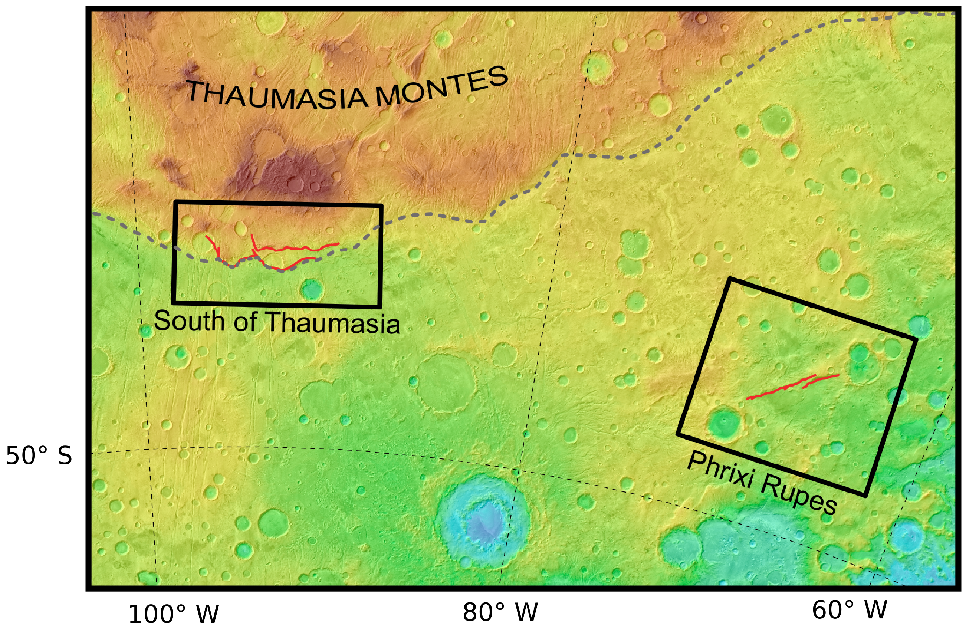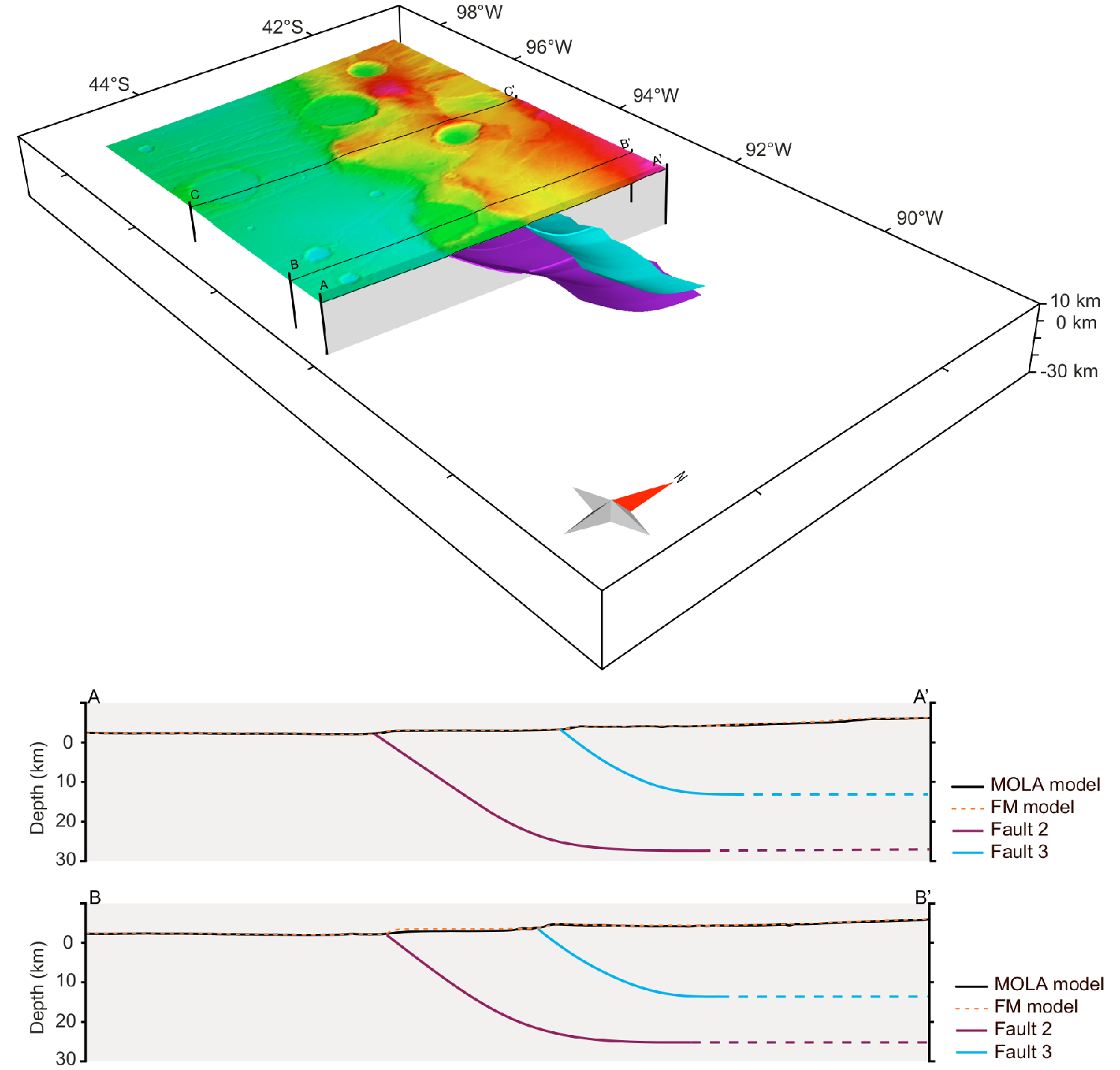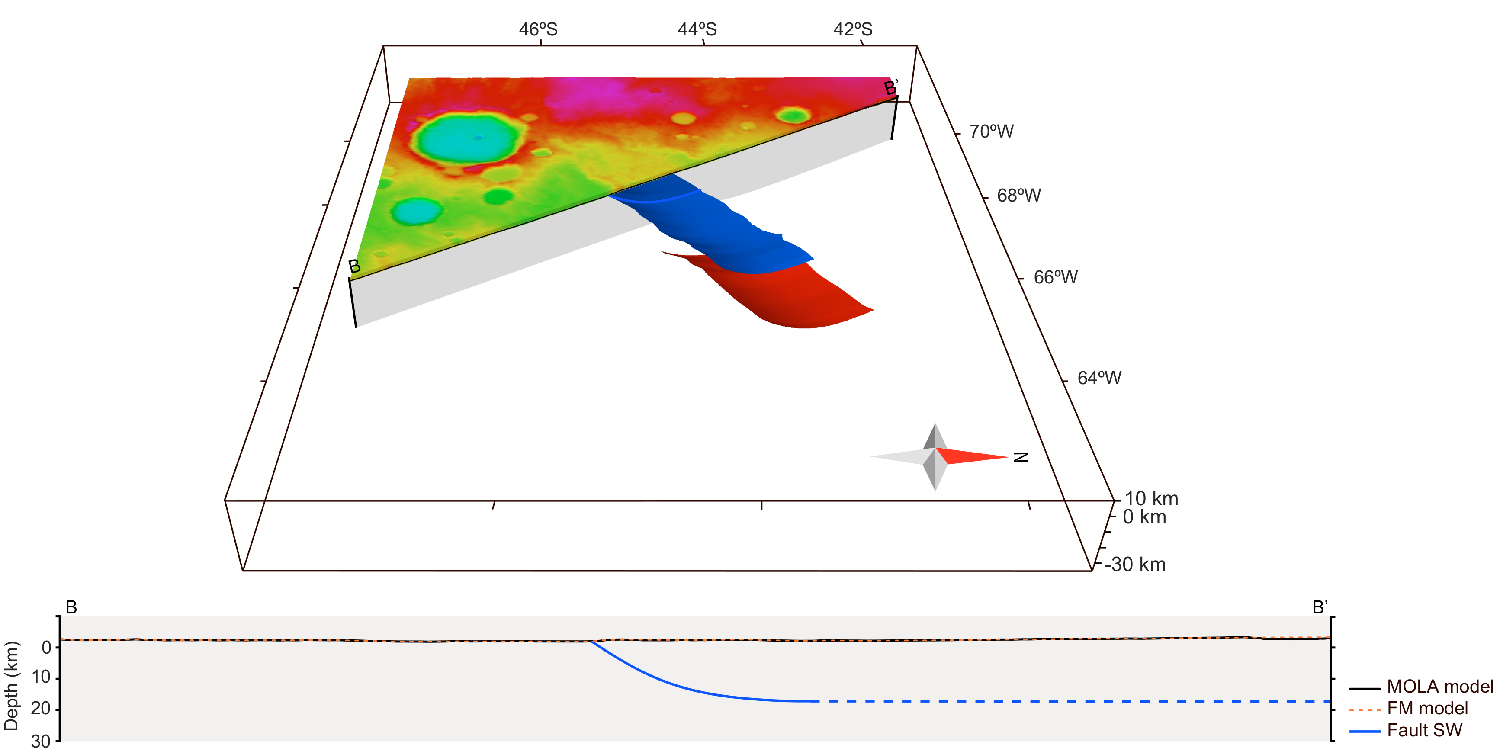- Universidad Complutense de Madrid, Facultad de Ciencias Geologicas, Departamento de Geodinámica Estratigrafía y Paleontología, Madrid, Spain (iromeobr@ucm.es)
Introduction
The structural modeling of lobate scarps, the topographic effect of surface breaking large thrust faults, have been accomplished by different techniques. 2D Mechanical forward dislocation models (Grott et al., 2007; Ruiz et al., 2008; Egea-Gonzalez et al., 2017, Herrero-Gil et al., 2019) and 2D balance area models (Mueller et al. 2014, Herrero-Gil et al., 2019) were applied to Martian lobate scarps. The recent development of robust 3D structural modeling software (MOVETM software suite, Petroleum Experts Ltd.; used for this study through the Academic Licence of the Universidad Complutense de Madrid) have allowed a more detailed 3D modeling approach that was successfully applied to Ogygis Rupes (Herrero-Gil et al., 2020a) and the Amenthes Thrust Fault System (Herrero-Gil et al., 2020b). Here we show the results of the obtained 3D structural models for 3 thrust faults at the southern boundary of the Warrego Rise (i.e. the boundary between the Thaumasia highlands and the adjacent Aonia Terra to the South) and the two main faults that make up Phrixi Rupes (located in Aonia Terra) (Fig.1).

Figure 1. Location of the studied thrust fault
Method
The structural modeling procedure consists in a pure geometrical approach assuming volume conservation. The deformation of the hanging wall is reproduced by fault parallel flow (Egan et al., 1997; Ziesch et al., 2014) and the propagation folding is modeled following the trishear algorithm (Erslev, 1991; Allmendinger, 1998). Full details of the modeling procedure can be found in Herrero-Gil et al. (2020a,b).
Structural modeling of thrust faults at the southern boundary of Warrego Rise
Three faults, producing the main thrusting of Thaumasia's Noachian basement over Aonia Terra, have been modeled in this area (Fig. 2). The obtained maximum fault slips range between 3366-2431 m, the fault dips of the upper planar part range from 33º to 40º, and the depths of faulting from 13 to 27 km. All the studied faults show listric geometries at depth indicating that they root at a detachment level.

Figure 2. 3D model of the Warrego Rise thrust faults
Structural modeling of the thrust faults of Phrixi Rupes
Two large faults generating Phrixi Rupes have been modeled (Fig.3). Their modeled maximum slips are 2847 m and 801 m, with common dip angles for the upper planar part of 33º-33,6º and depths of faulting ranging from 16 to 19 km.

Figure 3. 3D model of Phrixi Rupes thrust faults
Implications for the Circum-Tharsis tectonic contraction
The modeling results of this study together with the model for Ogygis Rupes (Herrero-Gil et al., 2020a) show some remarkable characteristics common to all the studied faults in this area: (1) all the main faults (excluding two subsidiary backthrusts in Ogygis Rupes) show an out-of-Tharsis vergence, (2) all of them have listric geometries at depth suggesting that they root at a detachment plane, (3) the depth of faulting of the main faults gets shallower in an out-of-Tharsis direction. Thus, our 3D structural modeling results support a common detachment level for all the modeled structures controlling a thick-skin tectonic style.
References
Allmendinger, R. (1998). Inverse and forward numerical modeling of trishear fault-propagation folds. Tectonics 17 (4), 640–656.
Egan, S.S., Buddin, T.S., Kane, S.J., Williams, G.D. (1997). Three-dimensional modelling and visualization in structural geology: new techniques for the restoration and balancing of volumes. In: Proceedings of the 1996 Geoscience Information Group Conference on Geological Visualization. In: Electron Geology, 1, 67–82.
Egea-González, I., Jiménez-Díaz, A., Parro, L. M., López, V., Williams, J.-P., Ruiz, J. (2017). Thrust fault modeling and Late-Noachian lithospheric structure of the circum-Hellas region, Mars. Icarus, 288, 53–68.
Erslev, E. (1991). Trishear fault-propagation folding. Geology 19, 617–620.
Grott, M., Hauber, E., Werner, S. C., Kronberg, P., Neukum, G. (2007). Mechanical modeling of thrust faults in the Thaumasia region, Mars, and implications for the Noachian heat flux. Icarus, 186(2), 517–526.
Herrero-Gil, A., Egea-González, I., Ruiz, J., Romeo, I. (2019). Structural modeling of lobate scarps in the NW margin of Argyre impact basin, Mars. Icarus 319, 367–380.
Herrero-Gil, A., Ruiz, J., Romeo, I. (2020a). 3D modeling of planetary lobate scarps: The case of Ogygis Rupes, Mars. Earth and Planetary Science Letters, 532, 116004.
Herrero‐Gil, A., Ruiz, J., Romeo, I. (2020b). Lithospheric contraction on Mars: a 3D model of the Amenthes thrust fault system. Journal of Geophysical Research: Planets, 125(3), e2019JE006201.
Mueller, K., Vidal, A., Robbins, S., Golombek, M., West, C. (2014). Fault and fold growth of the Amenthes uplift: Implications for Late Noachian crustal rheology and heat flow on Mars. Earth and Planetary Science Letters, 408, 100–109.
Ruiz, J., Fernandez, C., Gomez-Ortiz, D., Dohm, J.M., Lopez, V., Tejero, R. (2008). Ancient heat flow, crustal thickness, and lithospheric mantle rheology in the Amenthes region, Mars. Earth Planet. Sci. Lett. 270, 1–12.
Ziesch, J., Tanner, D.C., Krawczyk, C.M. (2014). Strain associated with the Fault-Parallel Flow algorithm during kinematic fault displacement. Math. Geosci. 46, 59–73.
How to cite: Herrero-Gil, A. and Romeo, I.: 3D Structural modeling of large thrust faults in Warrego Rise (southern Thaumasia) and Phrixi Rupes (Aonia Terra), Mars: implications for the architecture of a thrust fault system concentric to Tharsis., Europlanet Science Congress 2022, Granada, Spain, 18–23 Sep 2022, EPSC2022-388, https://doi.org/10.5194/epsc2022-388, 2022.

